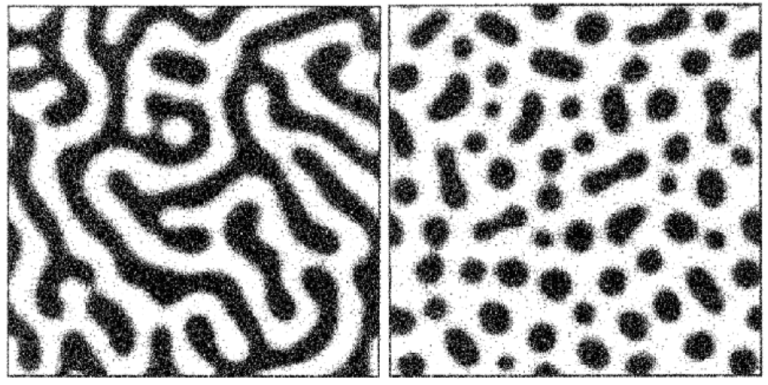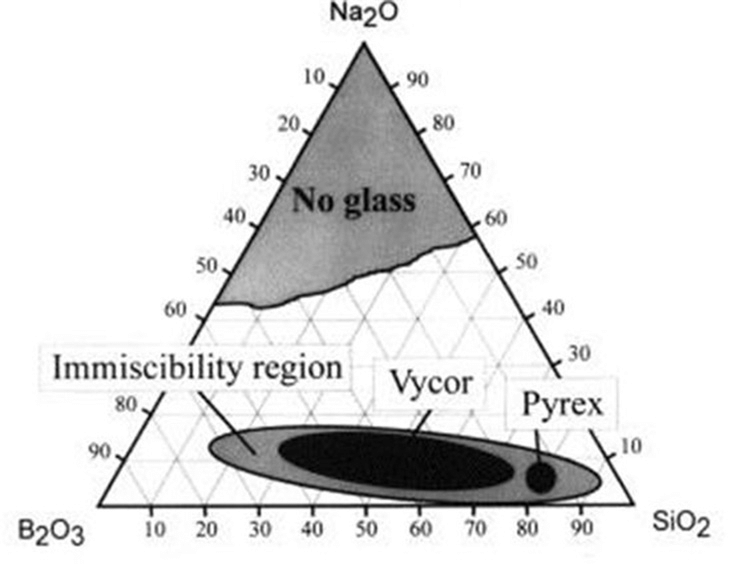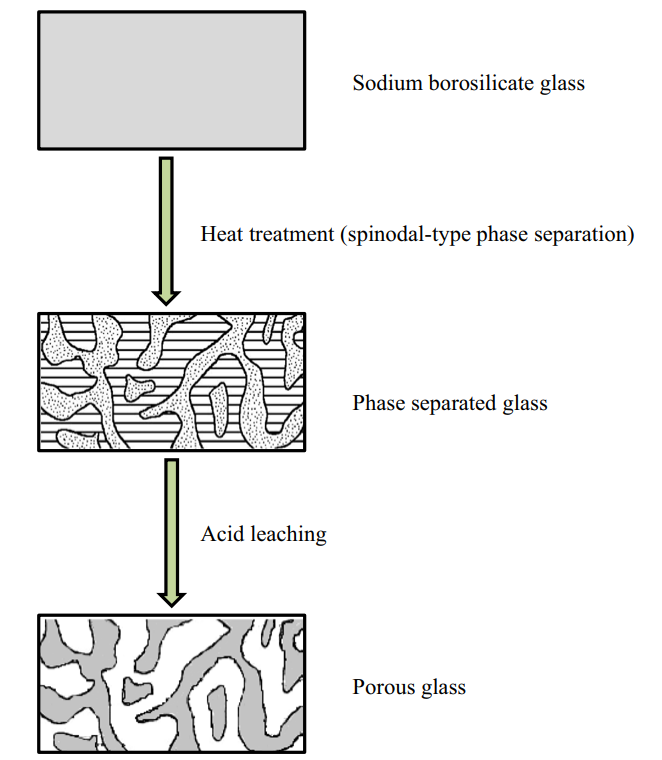Sponsored by Mo-SciApr 27 2022
While the phenomenon of phase separation has historically been a problem for glass producers, it is now known to offer advantages in the production of certain materials such as glass ceramics and porous glasses.
Whether desirable or undesirable, knowing how to control phase separation during the glass manufacturing process is critical. In this article, the basics of phase separation are discussed as well as outlining how it can be manipulated to produce advanced materials for a number of applications.
What is Phase Separation?
In physics and chemistry, the word “phase” gives reference to the region of a material that is chemically uniform and physically distinct. Phase separation, which is generally observed in liquids, is where a homogeneous mixture splits into two or more of these phases.
A common example is when a mixture of water and oil at room temperature naturally “phase separates” into two phases consisting of pure oil and another consisting of pure water. It can be said that such a mixture is “immiscible.”
Depending on the relative concentration of both components, the morphology of this phase separation can wildly vary.
If the mixture is mostly water, the oil phase will take shape by dispersing as distinct (or “discontinuous”) droplets throughout an interconnected (or “continuous”) water phase. If the mixture is mostly oil, the opposite effect will take place. When each amount of oil and water is roughly the same, the phases will tend to be continuous.
Phase Separation in Glass
Phase separation typically occurs in glass melts. Borosilicate glass – which is comprised of both silica and borate as network formers – is a well-known example.1,2
Contrary to the water/oil example, phases in glass melts are not always chemically pure. For instance, borosilicate glass will generally experience phase separation into a “borate-rich” phase and a “silica-rich” phase, with both phases being made up of different proportions of each network former.
Additionally, the morphology of separated phases in glass can fluctuate. While droplet-like phases can form via classical nucleation and growth, sudden “spinodal” phase separation can give rise to intertwined tendril-like phases continuously forming.3

On the left, spinodal decomposition produces “tendrils” of different phases. On the right, nucleation produces droplets of the darker phase within the lighter phase. (Gebauer et al., 2014)4.
This phase separation, which usually presents at high temperatures in the molten glass, persists and “freezes in” when cooling the glass into a solid. Both phases may form glasses after cooling if they are vitrifiable (this process is known as glass-glass phase separation).
However, if one phase is likely to crystallize, the mixture may cool into a glass-crystal phase-separated solid.5
For a long time, phase separation in glass was deemed undesirable – and for numerous applications, it still is.6 The existence of various phases changes the physico-chemical properties of glass melts, making it hard to mold and reducing the quality of the final glass.
Phase separation physics in glass-forming materials is extremely complex, and even today, the specific details are the subject of intense debates.7 However, glass manufacturers have nonetheless discovered ways of preventing or minimizing phase separation throughout the glass manufacturing process.
This is usually achieved by customizing the glass melt composition, with the occurrence of phase separation reserved for specific compositions. In a Na2O–B2O3–SiO2 glass system, for instance, the following ternary phase diagram shows the immiscibility region in which phase separation will take place.

Simplified ternary phase diagram for the Na2O–B2O3–SiO2 system. (Bartl et al., 2001)8.
Phase separation (and consquent crystallization) can also be regulated by adding glass modifiers and by adjusting heat treatment and cooling rate approaches.9
Controlling and Exploiting Phase Separation in Glass
Within the immiscibility region in the above diagram, two common commercial glass compositions are distinctly marked. It is now well accepted that phase separation provides certain benefits in particular applications.
Today, heterogeneous phase-separated glasses cover an extensive range of commercial applications, including glass ceramics, porous glass, Pyrex®, Vycor® and opal glass.
Glass-ceramics share many properties with both glasses and ceramics and are a known class of polycrystalline materials. They ideally provide the moldability of glasses amongst other unique properties of ceramics, such as high strength.
Glass-ceramics are created by the formation of crystal phases within an amorphous base glass (i.e., crystal-glass phase separation). Engineering glass-ceramics is contingent on controlling crystallization within the base material.10
Controlled phase separation also finds application in the production of porous glasses. Porous glasses are usually high-silica glasses comprised of pores with a specific size distribution, ranging from angstrom to millimeter scales.
Porous glasses are typically produced from the phase separation of alkali borosilicate glass, in which the mixture experiences spinodal phase separation after the application of heat treatment to create two continuous phases.11
Once phase separation is complete, acid can be used to dissolve the alkali-rich borate phase to remove it from the solid. This leaves behind a highly pure and porous silica glass “skeleton.”

Schematic showing the formation of porous glass from a phase-separated alkali (sodium) borosilicate mixture. (Hasanuzzaman et al 2016)11.
Porous glass demonstrates enhanced mechanical and thermal stability relative to ordinary bulk glass, making it a preferred alternative to fused quartz which is somewhat difficult to form. Other applications use the pores themselves: such as catalyst supports, filitering materials, and targeted drug delivery.12–16
Mo-Sci is a world-leading provider of sophisticated glasses for electronics, healthcare and engineering applications. Mo-Sci offers a complete range of glass-ceramic seals and porous glass solutions, as well as custom solutions for almost any glass application. Contact Mo-Sci today for further information.
References
- Charles, R. J. Phase Separation in Borosilicate Glasses. Journal of the American Ceramic Society 47, 559–563 (1964).
- Möncke, D., Ehrt, D. & Kamitsos, E. Spectroscopic study of manganese-containing borate and borosilicate glasses: Cluster formation and phase separation. Physics and Chemistry of Glasses – European Journal of Glass Science and Technology Part B 54, 42–51 (2013).
- Bergeron, C. G. & Risbud, S. H. Introduction to Phase Equilibria in Ceramics. (American Ceramic Society, 1984).
- Gebauer, D., Kellermeier, M., Gale, J., Bergström, L. & Cölfen, H. Pre-nucleation clusters as solute precursors in crystallisation. Chemical Society reviews 43, 2348–2371 (2014).
- Schuller, S. Phase separation in glass. (2018).
- Morey, G. W. The Properties of Glass. (Books on Demand, 1954).
- Da Vela, S. et al. Interplay between Glass Formation and Liquid–Liquid Phase Separation Revealed by the Scattering Invariant. J. Phys. Chem. Lett. 11, 7273–7278 (2020).
- Bartl, M. H., Gatterer, K., Fritzer, H. P. & Arafa, S. Investigation of phase separation in Nd3+ doped ternary sodium borosilicate glasses by optical spectroscopy. Spectrochimica Acta Part A: Molecular and Biomolecular Spectroscopy 57, 1991–1999 (2001).
- Liu, S., Zhang, Y. & Yue, Y. Effect of cooling rate on crystallization in an aluminophosphosilicate melt. Physics and Chemistry of Glasses – European Journal of Glass Science and Technology Part B 52, (2011).
- Control of nucleation in glass ceramics | Philosophical Transactions of the Royal Society of London. Series A: Mathematical, Physical and Engineering Sciences. https://royalsocietypublishing.org/doi/10.1098/rsta.2002.1152.
- Hasanuzzaman, M., Rafferty, A., Sajjia, M. & Olabi, A.-G. Production and Treatment of Porous Glass Materials for Advanced Usage. in Reference Module in Materials Science and Materials Engineering (Elsevier, 2016). doi:10.1016/b978-0-12-803581-8.03999-0.
- Hammel, J. J. & Allersma, T. United States Patent | Thermally stable and crush resistant microporous glass catalyst supports and methods of making. 341–341 (1975).
- Jungbauer, A. Chromatographic media for bioseparation. Journal of Chromatography A 1065, 3–12 (2005).
- Sotomayor, P. T. et al. Construction and evaluation of an optical pH sensor based on polyaniline-porous Vycor glass nanocomposite. in Sensors and Actuators, B: Chemical vol. 74 157–162 (2001).
- Takahashi, T., Yanagimoto, Y., Matsuoka, T. & Kai, T. Hydrogenation activity of benzenes on nickel catalysts supported on porous glass prepared from borosilicate glass with small amounts of metal oxides. Microporous Materials 6, 189–194 (1996).
- Using Porous Glass Microspheres for Targeted Drug Delivery Mo-Sci Corporation. https://mo-sci.com/porous-glass-microsphers-targeted-drug-delivery/.

This information has been sourced, reviewed and adapted from materials provided by Mo-Sci Corp.
For more information on this source, please visit Mo-Sci Corp.